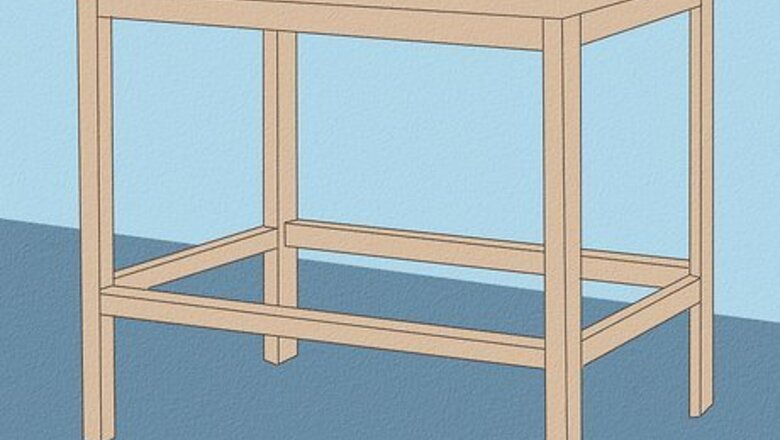
views
Prepping Your Cat for Brushing
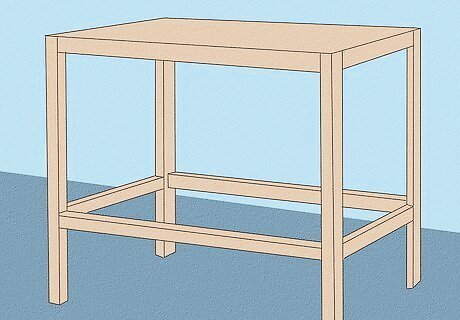
Pick a clean, high surface for the brushing. Start by choosing a spot in your home that is clean and easy for you to move around. A high table or counter that is wide enough for your cat is a good option. Spread all the brushing tools for your cat on the surface so they are easy to access. If your cat is more comfortable standing or sitting on the ground, you may brush it on the ground on a clean, hard surface, like hard wood.

Pet your cat to calm it down. Most cats will need to be in a calm and relaxed state to be brushed. Prepare your cat for the brushing session by giving it some attention and love. Pet its head and body, especially in spots that it likes. Place your cat on the high surface with the brushing tools on hand and pet it a few times to calm it down. Massage its head and start to brush its coat with your fingers to relax your cat. You may also say calming words as you pet your cat. For example, you may say, “Who’s a good kitty?” or “Are we ready to be brushed?” Continue to do this until your cat appears relaxed and at ease. This will make the brushing session much more enjoyable for you both.

Give your cat a treat. If your cat starts to get upset or annoyed when you prepare it for brushing, give your cat its favorite treat to snack on while you brush it. This could be catnip or other treats that it likes. You can also have cat treats on hand so you can give them to your cat if it starts to get annoyed or move around too much while you brush it.
Brushing Your Cat Properly

Work the metal comb through your cat’s coat from head to tail. Brush your cat with the metal comb in the direction your cat’s coat grows. Move from its head to its tail in long, sweeping motions. Make sure you brush its entire body, including its chest and abdomen. Focus on brushing one section of its body at a time. Brushing your cat in the opposite direction of its coat can cause the hair to lift up and make your cat feel uncomfortable. Stick to brushing with its coat, in the same direction, not against the growth of its coat.

Run the bristle brush in the direction of your cat’s head. Use the bristle brush to sweep any dead hair or skin that appears off your cat’s coat. Run the brush towards your cat’s head to do this. Then, smooth its hair down again with your fingers or by running the brush away from your cat’s head. Do this anywhere you see dead skin or dead hair on your cat’s coat. Keep in mind some cats may not like the sensation of being brushed in the opposite direction of its natural hair growth. It may take your cat some time to get used to this part of the brushing process. If your cat does not like to be brushed with the bristle brush or appears uncomfortable, you can skip this step.
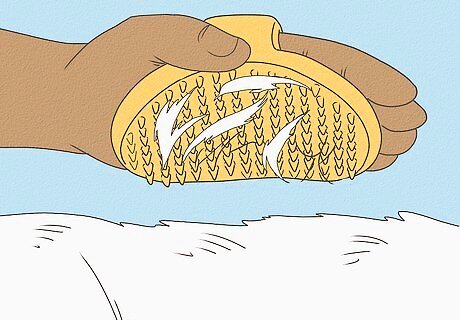
Use the rubber pad to remove dead hair. The rubber pad will be helpful for removing dead hair and stimulating blood circulation. Run the rubber pad from head to tail, making sure you remove any dead hair or flakes of skin. Do this all over your cat’s body, from head to tail, to ensure you remove as much dead hair and skin as possible on the surface of your cat’s coat. If you notice any dead hair or skin sitting on the surface of your cat’s coat after you are done using the rubber pad, you can remove them with a damp cloth or a rubber glove. Simply rub your cat’s coat lightly with the cloth or rubber glove to remove any remaining hair or skin.
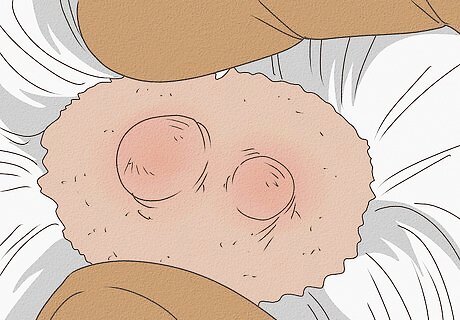
Look for any bumps, wounds, or tangles on your cat. As you brush your cat, make sure you check for any bumps or wounds on your cat’s coat. If you notice any bumps or wounds, examine them carefully and consider bringing your cat to the vet for a check up. Sometimes bumps or wounds on your cat’s coat can be a sign of a skin condition or a medical issue. If you notice any tangles or mats on your cat’s coat, do not try to remove them on your own. Often, pulling on big tangles or mats can make them worse and be painful for your cat. Instead, bring your cat to a professional groomer to have them clipped off. You can also bring your cat to the vet to get mats or tangles removed, though this will likely cost you more than going to a professional groomer to get this done.
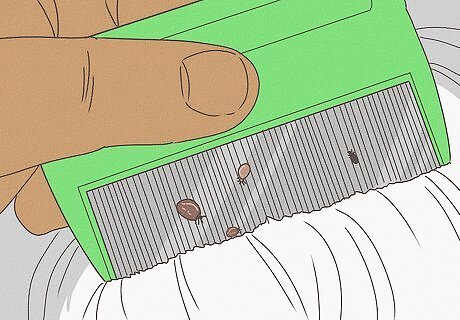
Check for fleas and ticks with the flea comb. During your cat’s brushing, make sure you also check for fleas and ticks. Use the flea comb to gently part your cat’s coat to check for any black specks of dried blood (or “flea dirt”) left behind by fleas. Look for any dead ticks in your cat’s coat, which will be very small and black. Because cats groom themselves so well, it is often hard to find adult fleas on cats. Flea dirt may be the only evidence of a flea infestation. To tell the difference between flea dirt and regular soil, wipe a little bit of the dirt off of your flea comb with a white tissue. Then, spray the tissue with water. Flea dirt will dissolve and turn red or rust-colored. You can also check your cat’s anus for any tan, rice-sized objects as these may indicate the presence of a tapeworm. If you see any signs of a parasite infestation, take your cat to the vet for evaluation and treatment.

Finish the brushing with praise and a treat. You should only brush your cat for as long as your cat tolerates it. If you notice any signs of stress in your cat, like growling, hissing, shaking of the head or swishing of the tail, stop the brushing session. Give your cat verbal praise, like “good kitty” or “great job,” and give it a treat. This will end the brushing on a positive note for your cat, making it easier for you to brush your cat in the future. Keep in mind the more often you brush your cat, the more comfortable it will become with the process. Over time, your cat should become less stressed or agitated when being brushed.
Maintaining a Regular Brushing Routine for Your Cat

Brush your short haired cat at least three times a week. Short haired cats do not need to be brushed every day. Try to brush your short haired cat three times a week on a regular basis so its coat is maintained and healthy. You may plan to brush your cat the same time and place three times a week so it gets used to the routine. Sticking to a regular brushing schedule for your cat will help you stay on top of any injuries as well as any fleas or ticks on your cat’s coat. Cats who are brushed regularly also tend to swallow less hair, which means you will not have to deal with hairballs.

Get your cat used to brushing when at a young age. Try to get your cat used to a brushing routine at a young age, starting when it is a kitten. This way, your cat will grow accustomed to be being brushed and be less stressed or agitated when you brush it. Starting early will also allow you to bond and connect to your cat, as brushing and grooming it can help you maintain a close relationship with your cat.
Have the same brushing routine every week for your cat. Follow the same procedures and steps every time you brush your cat. This way, your cat gets used to the routine and knows what to expect. Try extending your cat’s brushing sessions to be longer and longer as time goes on, as your cat may feel more relaxed and comfortable with the brushing routine. If you notice your cat does not like certain elements of the brushing routine, such as being brushed against the natural growth of its coat, change it up so you are brushing with the natural growth of its coat instead. This will ensure your cat is comfortable and enjoys the brushing sessions.




















Comments
0 comment